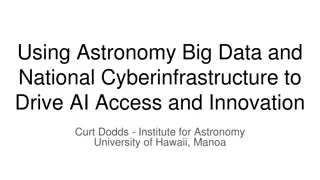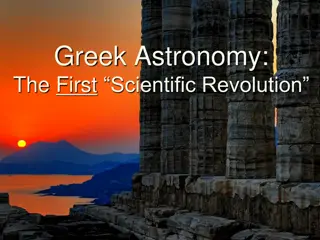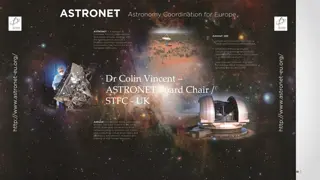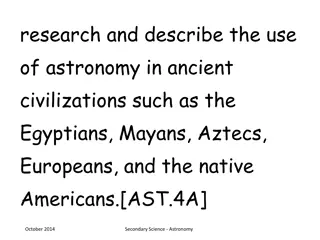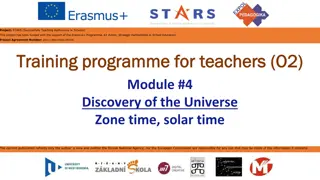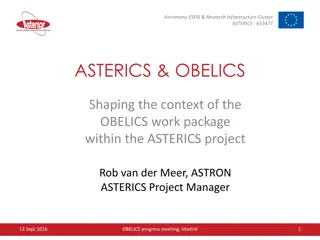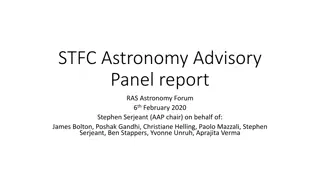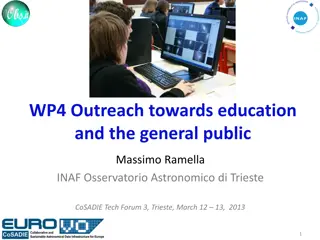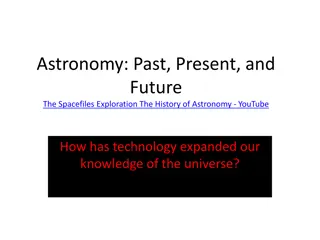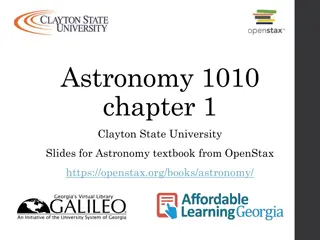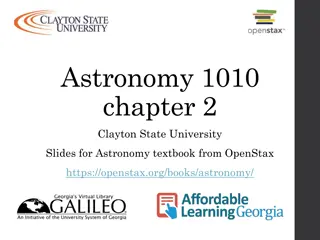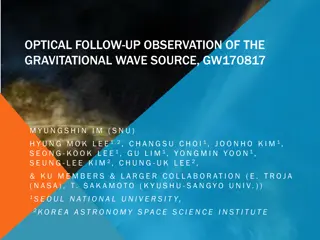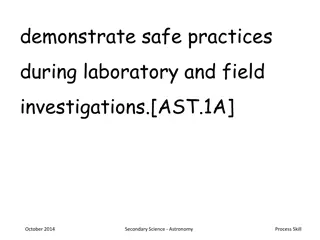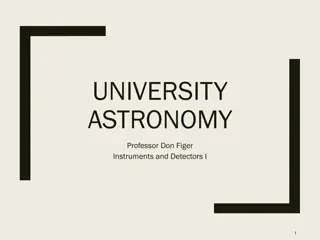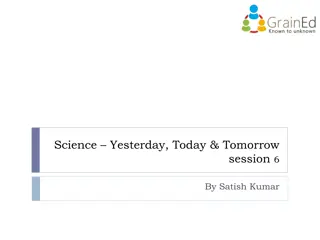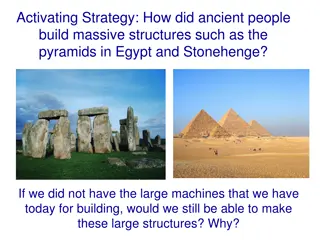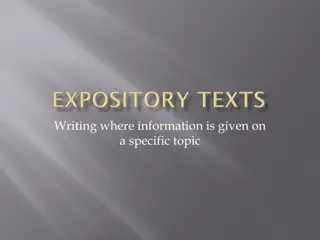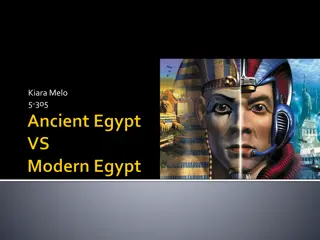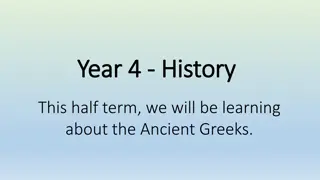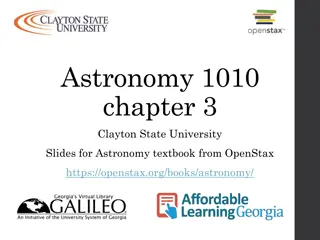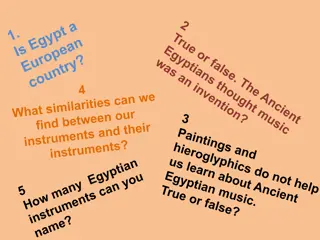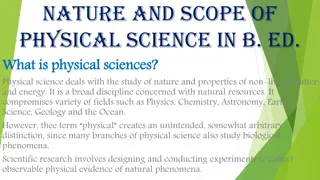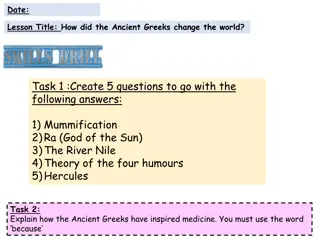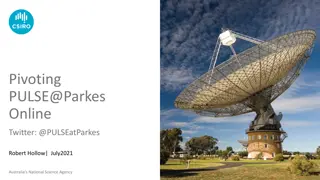The History of Astronomy: From Ancient Wonder to Modern Science
Astronomy, the oldest science, has fascinated humanity for millennia. From early interpretations of celestial bodies as gods to the development of instruments in Mesopotamia to predict events like eclipses, the evolution of astronomy is rich and diverse. Aristotle's theories on the cosmos laid the foundation for understanding celestial motion, paving the way for future scientific discoveries and advancements in the field.
Download Presentation

Please find below an Image/Link to download the presentation.
The content on the website is provided AS IS for your information and personal use only. It may not be sold, licensed, or shared on other websites without obtaining consent from the author. Download presentation by click this link. If you encounter any issues during the download, it is possible that the publisher has removed the file from their server.
E N D
Presentation Transcript
The History of Astronomy image: lookandlearn.com Written by David Ilsley
Astronomy is the oldest science. People naturally look at the sky and wonder about it. Though in the early days they had no way of knowing what those points of light were. They would explain them in terms of things they were familiar with like fire flies or lanterns. image: openclipart.org
When people started to farm crops about 10 000 years ago, it was important to sow the seed at the right time. Getting it wrong could mean starvation. image: commons.wikimedia.org
People noticed that the stars moved in regular ways and that they could be used to tell the time of year. So astronomers became important members of society. image: openclipart.org
People also saw the Sun, the Moon and the planets as gods that could affect their lives. Hence astrology was born. image: flickr.com
Beginning about 3000 BC in Mesopotamia, astronomers made instruments to measure the position of the heavenly bodies over time. This allowed them to predict events like eclipses. image: stocksnap.io
Although astronomers could predict the motion of the heavenly bodies, they still had no real idea what they were or why they moved. The first person to write an account of what they were and why they moved was Aristotle who lived in Greece about 300 BC. He stated that the Sun, Moon, planets and stars were set in concentric crystal spheres surrounding the Earth and that these spheres rotated around the Earth. He assumed that the Earth was stationary at the centre of the universe and that everything went around it.
Like this except that the celestial bodies would have been a lot smaller than the Earth and not so far away. image: flickr.com
Actually, another Greek named Aristarchus, who lived around the same time as Aristotle, suggested that the Sun was at the centre of the universe and that the Earth went around it. But no one took him very seriously. After all, you couldn t feel the Earth moving. image: commons.wikimedia.org
In 150 AD, another Greek, Ptolemy improved slightly on Aristotle s model of the universe by saying that the planets moved around small wheels which rotated on big wheels. This explained their retrograde motion. image: openclipart.org
This remained the accepted view of the universe amongst Western scholars for the next 1400 years. image: flickr.com
Then in 1543, Copernicus of Poland wrote a book arguing that a model of the universe with the Sun at the centre and the planets going around it better explained astronomical observations like the retrograde motion of the planets. image: openclipart.org image: flickr.com Unfortunately for him, Copernicus died the day his book was published.
Unlike with Aristarchus, many people in Europe were interested in Copernicus idea. Even the pope wrote to him before he published telling him to get a move on. image: picryl.com
In the late 1500s, Tycho Brahe, a rich Danish astronomer with a metal nose, kept very accurate records of the positions of the planets over many years. In 1600 he invited, Johannes Kepler to work with him. In 1601, 11 days after a banquet in Prague, Tycho died, possibly as a result of not going to the toilet at the banquet, or possibly of mercury poisoning. image: flickr.com
Kepler used Brahes observations to show that the planets orbit the Sun, but in elliptical orbits, not circular ones. image: commons.wikimedia.org
Meanwhile, in 1608 in the Netherlands, the telescope was invented. In 1609, the Italian, Galileo Galilei improved on the design and used his model to look at the sky. In particular, he saw four moons orbiting Jupiter. This threw a spanner into the idea that only the Earth had gravity. image: flickr.com
Although Copernicus had proposed the heliocentric universe 70 years earlier, most people still believed the Earth was at the centre. Galileo supported Copernicus idea. But by then, the Catholic Church had decided that, as the bible says that God made the Earth before the Sun, the Sun must go round the Earth. In 1632 Galileo was tried by the Inquisition, found guilty of heresy and sentenced to house arrest for the rest of his life. image: snl.no
The Catholic Church finally accepted that Galileo had been right in 1992.
In 1665, Isaac Newton, an Englishman, was sent home from university for two years to avoid the plague. In that time he came up with his laws of motion (which were very different from previous ideas) and his law of universal gravitation to explain the observations of Kepler, Galileo and others. To do this, he also had to invent calculus. image: commons.wikimedia.org Newton s laws became the basis of physics from that time on and were improved upon only in the 20th Century by Einstein.
So by the end of the 1600s, we knew pretty much what the solar system was and how it worked. Though we still didn t know what the stars were. Even through telescopes, they were still just points of light. image: publicdomainpictures.net
About a hundred years later, William Herschel, an English astronomer, showed that they were other Suns a long way away. After that, the universe was thought to consist of the Milky way galaxy with its stars and clouds of gas and dust, the Sun being one of those stars. Herschel also discovered Uranus. images: pixabay.com
The next big step forward was around 1900 when the theories of relativity and quantum mechanics were developed. These are fundamental to modern cosmology. image: pixabay.com
In the 1920s it was realised, mainly through the work of American astronomer, Edwin Hubble, that our galaxy, the Milky Way, is just one of millions. (Beforehand, visible galaxies were thought to be nebulae within the Milky Way.) It was also shown that other galaxies are moving away from us, i.e. the universe is expanding. image: commons.wikimedia.org
The Big Bang Theory and the Steady State Theory were developed to explain the expansion. With the discovery of the cosmic microwave background radiation by Robert Wilson and Arno Penzias in 1964, astronomers accepted the Big Bang. image: flickr.com
One significant discovery of the past few years is the discovery that many other stars have planetary system and thus that there is very likely to be life elsewhere in the universe. image: publicdomainpictures.net


